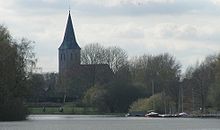St. Vincentius (Haselünne)
The Catholic Church of St. Vincentius in Haselünne is a late Gothic brick church in the Emsland district in Lower Saxony . It belongs to the parish of St. Vincentius Haselünne in the parish network Haselünne-Lehrte in the Diocese of Osnabrück .
History and architecture
The Church of St. Vincentius in Haselünne is a three-aisled, four-bay, late Gothic brick hall church from the last third of the 15th century, which is illuminated by high three-part windows with fish bubble tracery. The choir with a rectangular yoke and a five-eighth end is dated to 1509. The west tower was raised in 1471 and clad with Bentheim sandstone . The current end of the tower was built in 1860. A well-designed late Gothic west portal has been drawn together with the window above. The two-storey sacristy was built in the 16th century.
The slightly irregular floor plan with a wider south and narrow north aisle shows that older components were included in the new building. According to an inscription in the choir, the rector Herbord Monnich was killed in a construction accident in 1376. The west tower is shifted slightly to the north compared to the axis of the central nave and originally appears to have been part of a three-aisled structure from the 13th century.
Inside the four-bay hall church with slender round pillars and busted vaults, it can be seen that the foundation of at least the north aisle with the rectangular bays influenced the new building. The central nave and the choir are spanned with star vaults, the side aisles with cross vaults.
In 1976/77 the parish church of St. Vincentius was completely restored. Another interior renovation was carried out in 1998.
Furnishing
The furnishings include two figure-rich neo-Gothic carved altars. The high altar, which is carefully fitted into the choir, was created in 1900 by Bernhard Frydag from Münster. In the side altar is a small statue of the Virgin, which was designed by Wilhelm Heinrich Kocks around 1700, of which works in the chapel of Dankern Castle can also be verified .
The font on four lion feet comes from the 13th century. An artistically valuable Pietà with restrained expression was created at the beginning of the 16th century. Two larger-than-life wooden figures depicting John the Baptist and Saint Joseph were created at the beginning of the 18th century in the manner of Johann Wilhelm Gröninger .
Two large, artistically significant sandstone epitaphs have been preserved in the north aisle . In the west is the epitaph for Rudolf von Langen zu Schwarzenburg and Haselünne († 1610) and Margarete von Hake zu Schewentorf († 1637) with a relief of the resurrection between the pillars and numerous coats of arms, which was probably created by Gerhard Gröninger , too Epitaphs in the cathedral of Münster and in the Marienkirche in Osnabrück are preserved.
In the east there is a large epitaph for Caspar von Monnich, Herr zu Eichhof and Burgmann zu Haselünne († 1662) and Gertrud von Wendt († 1645) from Heinrich Meiering from Rheine. The two-storey, strongly plastic structure shows three reliefs from the Passion with the kneeling in front of it, in free plastic, with a relief of the Ascension of Christ above. The framing is unusually rich with figural ornamentation, similar to the high altar in Gravenhorst monastery .
A representation of the Man of Sorrows from the first half of the 18th century from the Jöllemann workshop (as in the Malgarten monastery ) was originally located in the Clariss monastery on site. Two large altarpieces by Ferdinand Abshoven from 1716 show the martyrdom of St. Vincentius and the Assumption of Mary. A chandelier from 1674 has also been preserved.
The organ was built in 1977 by the organ builders Gebrüder Stockmann . The slider chest instrument has 33 stops on two manuals and pedal . The game actions are mechanical, the stop actions are electric.
|
|
|
|||||||||||||||||||||||||||||||||||||||||||||||||||||||||||||||||||||||||||||||||||||||||||||||||||||||||||||||
- Coupling : II / I, I / P, II / P.
The oldest bells in the church date from 1406 and 1516 (from Wolter Westerhues ).
literature
- Georg Dehio : Handbook of the German art monuments. Bremen - Lower Saxony. Deutscher Kunstverlag, Munich, Berlin 1992, ISBN 3-422-03022-0 , pp. 653-654.
Individual evidence
- ↑ a b Information on the church on the website of the town of Haselünne. Retrieved April 27, 2018 .
- ↑ Information about the organ on orgbase.nl. Retrieved December 2, 2018 .
Web links
Coordinates: 52 ° 40 ′ 21.3 ″ N , 7 ° 29 ′ 8.7 ″ E


